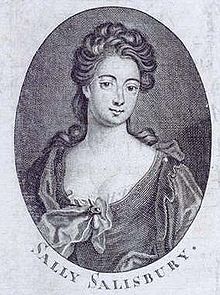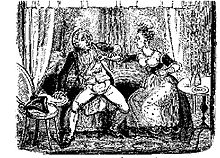- Sally Salisbury
-
Sally Salisbury 
Engraving of Sally Salisbury from the Authentic Memoirs of the Life, Intrigues and Adventures of the Celebrated Sally Salisbury (1723)Born Sarah Pridden
c.1690
London, EnglandDied 1724 (aged 33–34)
Newgate Prison, EnglandOccupation Prostitute Sally Salisbury (c.1692 – 1724), real name Sarah Pridden and also known as Sarah Priddon, was a celebrated prostitute in early 18th-century London. She was the lover of many notable members of society, and socialised with many others.
In 1722 she stabbed and wounded a client. As a result she was sentenced to one year's imprisonment. She was sent to Newgate Prison to serve her sentence but died in prison after only nine months.
Contents
Biography
She was born around 1690-1692 and given the name Sarah Pridden. Her father was a bricklayer. At the age of nine she was apprenticed to a seamstress in Aldgate. After losing a valuable piece of lace she ran away and took to life on the streets of the slum district of St Giles. Here she turned to various forms of street trading. She became well known in London as "the beautiful little wench who sells pamphlets to the schoolboys and apprentices...in Pope's Head Alley in the City of London", but her pamphlet sales were merely a sideline to her more lucrative trade, charging the boys half a crown for an hour of her time.[1] The notorious roué Colonel Francis Charteris made her his mistress, but abandoned her when she was 14, after which she was taken in by the bawd, Mother Wisebourne, whose house in Covent Garden was among the most exclusive and expensive brothels of the time. She adopted the name Salisbury from one of her lovers. After Wisebourne's death she moved on to the house of Mother Needham in Park Place.
Celebrity prostitute
She was celebrated for her beauty and wit and attracted many aristocratic customers. The Secretary of State, Viscount Bolingbroke was a great admirer, willing to pay "the highest price for the greatest pleasure" and she boasted that she had "at least half a score" of lords as clients.[2] The Duke of Richmond, the poet and diplomat Matthew Prior, and Nell Gwyn's son, the Duke of St Albans all patronised her, and even the future George II was rumoured to have been amongst her lovers.[3]
She spent time in Marshalsea and Bridewell prisons for minor offences and debt. After a riot at Wisebourne's house in 1713 she was sent to Newgate Prison but was released by Judge Blagney who had become infatuated with her.
Stabbing
The stabbing took place as the result of an argument over some opera tickets that a customer, John Finch, the son of the Countess of Winchelsea and brother to Lord Finch, had given to Sally's sister instead of Sally. During the argument in the Three Tuns Tavern in Chandos Street, Covent Garden, Finch and Salisbury both became angry and Salisbury snatched up the knife she had been given with her meal and stabbed Finch in the chest. She was apparently immediately remorseful and called for a surgeon to attend Finch. Finch was gravely ill for some time, but forgave Salisbury on the spot. When he later recovered, he wished to visit her in prison to reiterate his forgiveness.
The incident was the talk of the town, as Salisbury was a celebrity in London and her every move reported. Lady Mary Wortley Montagu wrote to the Countess of Mar in Paris of the gossip a few days after the event:[4]
The freshest news in town is the fatal accident happened three nights ago to a very pretty young fellow, brother to Lord Finch, who was drinking with a dearly beloved drab, whom you may have heard of by the name of Sally Salisbury. In a jealous pique she stabbed him to the heart with a knife. He fell down dead immediately, but a surgeon being called for, and the knife drawn out of his body, he opened his eyes, and his first words were to beg her to be friends with him, and kissed her. She has since stayed by his bedside till last night, when he begged her to fly, for he thought he could not live; she has taken his advice and perhaps will honour you with her residence in Paris.
—Lady Mary Wortley Montagu - c. 25 December 1722
Trial and imprisonment
Salisbury was charged with violent assault and tried at the Old Bailey on 24 April 1723. Her lawyer claimed that the act had not been premeditated and that Mr. Finch's forgiveness should count in her favour. The defense also tried to argue that Sally had acted to defend her sister from Mr. Finch's dishonorable amorous intentions, rather than from jealousy.[5] The prosecution mocked her reputation and claimed that Finch's forgiveness showed only his amiable character and offered nothing in the way of mitigation. The jury found her guilty of assaulting and wounding Finch but acquitted her of intent to murder. She was sentenced to pay a fine of 100 pounds, a year's imprisonment and to find sureties for her behaviour for two years.
Salisbury's esteemed patrons did not abandon her: she received visitors while in prison awaiting trial and the courtroom was packed with notables of London society during the trial. After she was taken to Newgate, she continued to receive visitors who brought her luxury goods and made sure that she was comfortable during her imprisonment. After serving nine months of her sentence she died of "brain fever brought on by debauch", almost certainly syphilis,[2] and was buried in the churchyard of St. Andrew, at Holborn.
Legacy
She was the subject of a number of biographies, among them the anonymous, The Genuine History of Mrs. Sarah Pridden, usually called Sally Salisbury, and Her Gallants, and Captain Charles Walker's Authentic Memoirs of the Life, Intrigues and Adventures of the Celebrated Sally Salisbury, both from 1723, as well as receiving mention in César de Saussure's A Foreign View of England.
She is a possible inspiration for the harlot, Moll Hackabout, in Hogarth's A Harlot's Progress: her lover Charteris features in the series and, like Moll, Salisbury had spent time in Bridewell. She was thought to be the satirical subject of the song Sally in Our Alley until the author, Henry Carey, claimed he had not heard of her when he wrote it.
Notes
- ^ Maureen Waller (2002). 1700: Scenes from London Life. Four Walls Eight Windows. pp. 400. ISBN 1568582161.
- ^ a b Lucy Moore (2000). The Thieves' Opera. Harvest Books. pp. 304. ISBN 0156006405.
- ^ Fergus Linnane (2005). London's Underworld: Three Centuries of Vice and Crime. Robson Books. pp. 372. ISBN 1861057423.
- ^ Lady Mary Wortley Montagu (2005). Letters from the Right Honourable Lady Mary Wortley Montagu 1709 to 1762. Kessinger Publishing. p. 564. ISBN 141790741X.
- ^ Rosenthal, Laura J. "The Whore's Estate: Sally Salisbury, Prostitution, and Property in Eighteenth-Century London". Women, Property and the Letters of the Law in Early Modern England. Ed. Margaret W. Ferguson, Nancy E. Wright, A. R. Buck. University of Toronto Press, 2004. pg 100.
References
- "The Newgate Calendar: Sarah Priddon". http://www.exclassics.com/newgate/ng415.htm. Retrieved 4 April 2007.
- Lucy Moore (2000). The Thieves' Opera. Harvest Books. pp. 304. ISBN 0156006405.
Categories:- 1690s births
- 1724 deaths
- English prostitutes
- English criminals
- Marshalsea
- People imprisoned for debt
Wikimedia Foundation. 2010.

